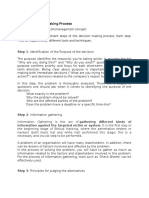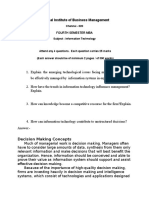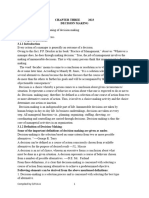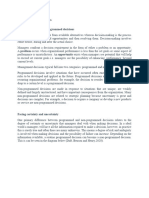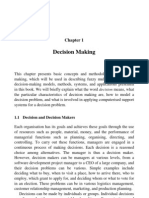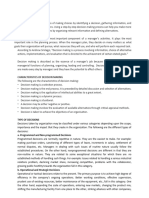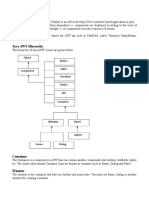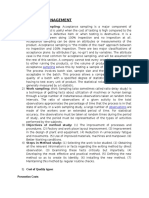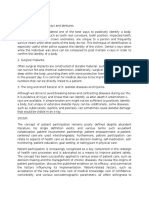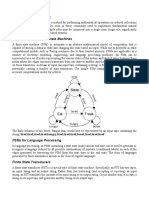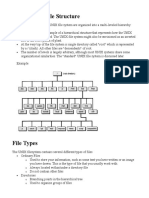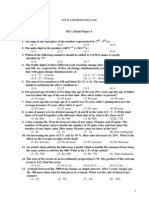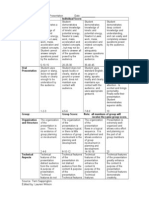1) Comparison Between MIS and DSS
1) Comparison Between MIS and DSS
Uploaded by
Abhisek SarkarCopyright:
Available Formats
1) Comparison Between MIS and DSS
1) Comparison Between MIS and DSS
Uploaded by
Abhisek SarkarOriginal Description:
Original Title
Copyright
Available Formats
Share this document
Did you find this document useful?
Is this content inappropriate?
Copyright:
Available Formats
1) Comparison Between MIS and DSS
1) Comparison Between MIS and DSS
Uploaded by
Abhisek SarkarCopyright:
Available Formats
1)Comparison between MIS and DSS:
S.NO. MIS
DSS
1.
The main focus is on the structured tasks Focus is mainly on the semi / unand the routine decisions.
structured tasks, which demand the
managerial judgment.
2.
Identifies the information requirement.
Develops certain tools for using in the
decision process.
3.
Data storage is of great importance
The main emphasis is on the data
manipulation.
4.
Delivers system depending on the frozen Current data can be used in the Decision
requirements.
Support System.
5.
Only the in direct access to the data by
the managers is provided.
Managers enjoy direct access to the data.
6.
Very much dependent on the computer
expert.
Depends on the managerial judgment.
7.
Access to the data possibly requiring a
wait for the managers turn.
Waiting is not at all required.
8.
MIS manager may not completely
understand the nature of the decision.
Manager possesses the knowledge about
the nature of the decision and the decision
making environment.
9.
Main stress is on the efficiency.
Main emphasis is laid on the
effectiveness.
2) Decision making
Decision making is a daily activity for any human being. There is no exception about that. When it comes to
business organizations, decision making is a habit and a process as well.
Effective and successful decisions make profit to the company and unsuccessful ones make losses. Therefore,
corporate decision making process is the most critical process in any organization.
In the decision making process, we choose one course of action from a few possible alternatives. In the process
of decision making, we may use many tools, techniques and perceptions.
In addition, we may make our own private decisions or may prefer a collective decision.
Usually, decision making is hard. Majority of corporate decisions involve some level of dissatisfaction or
conflict with another party.
Let's have a look at the decision making process in detail.
Steps of Decision Making Process
Following are the important steps of the decision making process. Each step may be supported by different
tools and techniques.
Step 1: Identification of the purpose of the decision
In this step, the problem is thoroughly analysed. There are a couple of questions one should ask when it comes
to identifying the purpose of the decision.
Step 2: Information gathering
A problem of an organization will have many stakeholders. In addition, there can be dozens of factors involved
and affected by the problem.
In the process of solving the problem, you will have to gather as much as information related to the factors and
stakeholders involved in the problem. For the process of information gathering, tools such as 'Check Sheets'
can be effectively used.
Step 3: Principles for judging the alternatives
In this step, the baseline criteria for judging the alternatives should be set up. When it comes to defining the
criteria, organizational goals as well as the corporate culture should be taken into consideration.
As an example, profit is one of the main concerns in every decision making process. Companies usually do not
make decisions that reduce profits, unless it is an exceptional case. Likewise, baseline principles should be
identified related to the problem in hand.
Step 4: Brainstorm and analyse the different choices
For this step, brainstorming to list down all the ideas is the best option. Before the idea generation step, it is
vital to understand the causes of the problem and prioritization of causes.
For this, you can make use of Cause-and-Effect diagrams and Pareto Chart tool. Cause-and-Effect diagram
helps you to identify all possible causes of the problem and Pareto chart helps you to prioritize and identify the
causes with highest effect.
Step 5: Evaluation of alternatives
Use your judgement principles and decision-making criteria to evaluate each alternative. In this step,
experience and effectiveness of the judgement principles come into play. You need to compare each alternative
for their positives and negatives.
Step 6: Select the best alternative
Once you go through from Step 1 to Step 5, this step is easy. In addition, the selection of the best alternative is
an informed decision since you have already followed a methodology to derive and select the best alternative.
Step 7: Execute the decision
Convert your decision into a plan or a sequence of activities. Execute your plan by yourself or with the help of
subordinates.
Step 8: Evaluate the results
Evaluate the outcome of your decision. See whether there is anything you should learn and then correct in
future decision making. This is one of the best practices that will improve your decision-making skills.
Fig: Flowchart of Decision making process.
You might also like
- Decision Making ProcessDocument5 pagesDecision Making ProcessManish Singh100% (1)
- Consumer Decision Making ProcessDocument14 pagesConsumer Decision Making Processanandvvism100% (1)
- Chapter 15 Sensory Pathways and The Somatic Nervous SystemDocument35 pagesChapter 15 Sensory Pathways and The Somatic Nervous Systemlolasparkle0% (1)
- Decision Making ProcessDocument4 pagesDecision Making ProcessFrancis KoNo ratings yet
- Decision MakingDocument4 pagesDecision MakingSana ShaikNo ratings yet
- Managerial Decision MakingDocument7 pagesManagerial Decision MakingJaya Mae ApolinarioNo ratings yet
- Decision Making Ankita 09Document38 pagesDecision Making Ankita 09RadHika GaNdotraNo ratings yet
- Information TechnologyDocument22 pagesInformation TechnologyArjun GhoseNo ratings yet
- Concept of Decision MakingDocument12 pagesConcept of Decision MakingLeilani JohnsonNo ratings yet
- CFLM2 Character Formation 2Document35 pagesCFLM2 Character Formation 2Joshua MalmisNo ratings yet
- Types of Decisions Unstructured/ Nonprogrammed Structured/ Programmed Semi-StructuredDocument10 pagesTypes of Decisions Unstructured/ Nonprogrammed Structured/ Programmed Semi-Structuredmadhu4uraoNo ratings yet
- Chapter 4 DMDocument14 pagesChapter 4 DMyirgalemle ayeNo ratings yet
- Decision MakingDocument6 pagesDecision MakingLovenia M. FerrerNo ratings yet
- International Trade.Document31 pagesInternational Trade.Erika Therese N. BariquitNo ratings yet
- Chapter 3 Decision MakingDocument41 pagesChapter 3 Decision Makingarooj100% (1)
- DECISION MAKING CH 3Document6 pagesDECISION MAKING CH 3Eliyas ManNo ratings yet
- EE14-Module 2Document7 pagesEE14-Module 2PINEDA CRISTIAN PAUL C.No ratings yet
- Chapter 3 BMIS SCMSBDocument75 pagesChapter 3 BMIS SCMSBNainika ReddyNo ratings yet
- UNIT 2 MisDocument36 pagesUNIT 2 Mis2003vishalkypNo ratings yet
- Chapter 5Document4 pagesChapter 5Ryam Enaj BonitoNo ratings yet
- Decision Making Decision Making Process DefinedDocument8 pagesDecision Making Decision Making Process DefinedRupert Rosel AmatorioNo ratings yet
- Forecasting: Forecasting Is A Process of Predicting or Estimating The Future Based On Past and Present DataDocument5 pagesForecasting: Forecasting Is A Process of Predicting or Estimating The Future Based On Past and Present DataHimanshu DarganNo ratings yet
- Forecasting: Forecasting Is A Process of Predicting or Estimating The Future Based On Past and Present DataDocument5 pagesForecasting: Forecasting Is A Process of Predicting or Estimating The Future Based On Past and Present DataHIMANSHU DARGANNo ratings yet
- Mis Presentation To SpeakDocument25 pagesMis Presentation To Speakkhushi jainNo ratings yet
- Mod 2 NotesDocument19 pagesMod 2 NotesDhaarani SekarNo ratings yet
- 4th chapter ethical FinanceDocument5 pages4th chapter ethical FinanceconevaluationNo ratings yet
- Chapter 4Document3 pagesChapter 4Edron ClydeNo ratings yet
- Decision MakingDocument6 pagesDecision Makingvasant1234No ratings yet
- Descision MakingDocument31 pagesDescision MakingZeeLazMursalinNo ratings yet
- Chapter 4Document8 pagesChapter 4azmerawNo ratings yet
- Unit 10 Canvas Notes For CW2Document11 pagesUnit 10 Canvas Notes For CW2May Nantha KhinNo ratings yet
- Decision MakingDocument5 pagesDecision MakingSandy BuronNo ratings yet
- MCDM-IntroductionDocument72 pagesMCDM-IntroductionAkhilesh MandalNo ratings yet
- Unit 2 Decision ProcessDocument67 pagesUnit 2 Decision ProcessPriyadarshini SNo ratings yet
- Chapter 4 - Decision MakingDocument5 pagesChapter 4 - Decision MakingEthio P100% (1)
- Mis and Decision Making ConceptsDocument7 pagesMis and Decision Making Conceptssaravana saravanaNo ratings yet
- Effective Decision MakingDocument41 pagesEffective Decision MakingAjanthan AlagaratnamNo ratings yet
- Decision Making ProcessDocument3 pagesDecision Making ProcessSan RaiNo ratings yet
- Presentaion of Mis 2...Document10 pagesPresentaion of Mis 2...Akesh GuptaNo ratings yet
- Decision Making New Design FinalDocument25 pagesDecision Making New Design Finalmohamed.aliNo ratings yet
- Decision Making: 1.1 Decision and Decision MakersDocument13 pagesDecision Making: 1.1 Decision and Decision MakersTiba MihaelaNo ratings yet
- A Decision Support SystemDocument2 pagesA Decision Support SystemNeeraj JainNo ratings yet
- Course Introduction: Rift Valley Center For Distance Education Management Information SystemDocument116 pagesCourse Introduction: Rift Valley Center For Distance Education Management Information SystemRachel HaileNo ratings yet
- Character Formation Module 5 6 7Document23 pagesCharacter Formation Module 5 6 7RAYMOND CALSADA100% (1)
- BY: Jayati Negi Dushyant Nishant ArchanaDocument18 pagesBY: Jayati Negi Dushyant Nishant ArchanaJoy Negi100% (1)
- Module 3 Lesson 6Document4 pagesModule 3 Lesson 6John Benz SamsonNo ratings yet
- Types of DecisionsDocument10 pagesTypes of DecisionsKritika KapoorNo ratings yet
- BE Decision MakingDocument17 pagesBE Decision Makingguest956271No ratings yet
- Full Management 9Th Edition Daft Solutions Manual Online PDF All ChapterDocument44 pagesFull Management 9Th Edition Daft Solutions Manual Online PDF All Chaptercarloschallenger484886100% (10)
- Decision Making Meaning, Nature, Characteristics, Elements and ProcessDocument4 pagesDecision Making Meaning, Nature, Characteristics, Elements and ProcessPRODYOT SINHANo ratings yet
- ASSIGNMENTDocument5 pagesASSIGNMENTNamra FahadNo ratings yet
- POM Notes_Unit_3Document9 pagesPOM Notes_Unit_3sheikhmdashif78No ratings yet
- Simon's ModelDocument6 pagesSimon's ModelVinay KanasuNo ratings yet
- Decision MakingDocument6 pagesDecision MakingAMALA ANo ratings yet
- Unit 4 Managerial Decision MakingDocument21 pagesUnit 4 Managerial Decision Makinglingeshwarkulal106No ratings yet
- Decision MakingDocument7 pagesDecision MakingPrakhar PandeyNo ratings yet
- Unit-1 Overview of Different Types of Decision Making. SyllabusDocument22 pagesUnit-1 Overview of Different Types of Decision Making. SyllabusshivaniNo ratings yet
- Note On House Rent AllowanceDocument5 pagesNote On House Rent AllowanceAbhisek SarkarNo ratings yet
- Hardware & Software RequirementDocument1 pageHardware & Software RequirementAbhisek SarkarNo ratings yet
- Adaptation in PlantsDocument3 pagesAdaptation in PlantsAbhisek SarkarNo ratings yet
- Botany PracticalDocument1 pageBotany PracticalAbhisek SarkarNo ratings yet
- Java AwtDocument2 pagesJava AwtAbhisek Sarkar100% (1)
- Bipolar 8-Zero Substitution (B8ZS) : Encoding T1 VoltageDocument1 pageBipolar 8-Zero Substitution (B8ZS) : Encoding T1 VoltageAbhisek SarkarNo ratings yet
- Production Management: SamplingDocument4 pagesProduction Management: SamplingAbhisek Sarkar0% (1)
- 4P's of SPMDocument1 page4P's of SPMAbhisek SarkarNo ratings yet
- Abiotic/Physical Component: Biology Chemical Physical Environment Evolution GeodiversityDocument3 pagesAbiotic/Physical Component: Biology Chemical Physical Environment Evolution GeodiversityAbhisek SarkarNo ratings yet
- Collaboration, Patient Involvement, Partnership, Patient Empowerment, or Patient-Centered Care Are Used Interchangeably. Furthermore, Patient Participation CanDocument2 pagesCollaboration, Patient Involvement, Partnership, Patient Empowerment, or Patient-Centered Care Are Used Interchangeably. Furthermore, Patient Participation CanAbhisek SarkarNo ratings yet
- Interactive Computer Graphics and Passive Computer GraphicsDocument1 pageInteractive Computer Graphics and Passive Computer GraphicsAbhisek SarkarNo ratings yet
- Wage and SalaryDocument2 pagesWage and SalaryAbhisek Sarkar100% (1)
- What Is A Neural Network?Document3 pagesWhat Is A Neural Network?Abhisek SarkarNo ratings yet
- Eye Outpatient Satisfaction Survey (For General Information)Document3 pagesEye Outpatient Satisfaction Survey (For General Information)Abhisek SarkarNo ratings yet
- Finite State TransducersDocument4 pagesFinite State TransducersAbhisek SarkarNo ratings yet
- Mothers Day CelebrationDocument1 pageMothers Day CelebrationAbhisek Sarkar100% (1)
- Hierarchical File StructureDocument2 pagesHierarchical File StructureAbhisek SarkarNo ratings yet
- Types/Levels of Cache MemoryDocument1 pageTypes/Levels of Cache MemoryAbhisek SarkarNo ratings yet
- The Fetch-Decode-Execute CycleDocument3 pagesThe Fetch-Decode-Execute CycleAbhisek SarkarNo ratings yet
- Sad IgnouDocument4 pagesSad IgnouAbhisek SarkarNo ratings yet
- Tancet Mca Model Paper 4Document8 pagesTancet Mca Model Paper 4Saddam HussainNo ratings yet
- Oxford Learner's Bookshelf e-books for learning English 12Document1 pageOxford Learner's Bookshelf e-books for learning English 12rasha qaruotiNo ratings yet
- Earth's Atmosphere: "Air" Redirects Here. For Other Uses, SeeDocument18 pagesEarth's Atmosphere: "Air" Redirects Here. For Other Uses, SeeSatya ReddyNo ratings yet
- RubricDocument2 pagesRubricapi-249404110No ratings yet
- Warning PJ OubliDocument8 pagesWarning PJ OubliMamadou ThioyeNo ratings yet
- Way To Get The Best Web Design Company in QatarDocument3 pagesWay To Get The Best Web Design Company in QatarAlfaoneinfotechNo ratings yet
- A Study On The in Uence of Consumer Lifestyle Over The Buying Behaviour Towards FMCG Products: Special Reference To DaburDocument10 pagesA Study On The in Uence of Consumer Lifestyle Over The Buying Behaviour Towards FMCG Products: Special Reference To Dabursanika ponksheNo ratings yet
- Kaml RamDocument22 pagesKaml RamahmadtaiyabiNo ratings yet
- Ece341 SP12 Midterm Exam Practice QuestionsDocument3 pagesEce341 SP12 Midterm Exam Practice QuestionsAdam SummersNo ratings yet
- Students Satisfaction Level Towards Enrollment System Services Provided1 1Document13 pagesStudents Satisfaction Level Towards Enrollment System Services Provided1 1MOB Psycho100% (1)
- Rizwan Ullah: About MeDocument1 pageRizwan Ullah: About Memn1342223No ratings yet
- CPQ Developer GuideDocument86 pagesCPQ Developer GuideAlberto EinsteinNo ratings yet
- Note TVC (Transversality Condition)Document3 pagesNote TVC (Transversality Condition)David BoninNo ratings yet
- All CLARiiON Disk and FLARE OE MatricesDocument60 pagesAll CLARiiON Disk and FLARE OE MatricesGauurav SabharwalNo ratings yet
- Multi Loop CircuitsDocument25 pagesMulti Loop CircuitsChris Osea AlvarezNo ratings yet
- Sidecut Sc3C: Building of Fiber Optic Networks in An Urban Environment FTTXDocument2 pagesSidecut Sc3C: Building of Fiber Optic Networks in An Urban Environment FTTXEdwin Alfonso Hernandez MontesNo ratings yet
- Cbap Ccba RoadmapDocument6 pagesCbap Ccba RoadmapRavi ViswanathanNo ratings yet
- Reference Material Price List: GasolineDocument2 pagesReference Material Price List: GasolineAnonh AdikoNo ratings yet
- 232-2023FDP2-AIML BrochureDocument2 pages232-2023FDP2-AIML BrochureDr PNo ratings yet
- Well Maintenance Procedures STAP G 1 M 20106Document17 pagesWell Maintenance Procedures STAP G 1 M 20106Danian Primasatrya100% (3)
- Teaching and Assessment of The Macro Skills Questionnaire Assess 3Document5 pagesTeaching and Assessment of The Macro Skills Questionnaire Assess 3forsythiachrysanthemumNo ratings yet
- Cloud Services Agreement TemplateDocument3 pagesCloud Services Agreement TemplateNguyen Vinh NamNo ratings yet
- Penyebaran Fahaman Bertentangan Akidah Islam Di Media Sosial Dari Perspektif Undang-Undang Dan Syariah Di MalaysiaDocument12 pagesPenyebaran Fahaman Bertentangan Akidah Islam Di Media Sosial Dari Perspektif Undang-Undang Dan Syariah Di Malaysia2023225596No ratings yet
- Of Crystalsand Semiotic Slippage AQJuneaccepted 2023Document37 pagesOf Crystalsand Semiotic Slippage AQJuneaccepted 2023Felix PriceNo ratings yet
- Marine Industries in MYDocument3 pagesMarine Industries in MYaduhaiyaNo ratings yet
- World Literature: Theories in The Context of GlobalizationDocument1 pageWorld Literature: Theories in The Context of GlobalizationAna Lei Za ErtsivelNo ratings yet
- NobleAndrea 2005 BOOKCOVER MexicanNationalCinema PDFDocument60 pagesNobleAndrea 2005 BOOKCOVER MexicanNationalCinema PDFLuis S. FríasNo ratings yet
- CSF Metro PDFDocument18 pagesCSF Metro PDFAastha ShahNo ratings yet
- 68-0003-B09-0005 - Cold Room CeilingDocument30 pages68-0003-B09-0005 - Cold Room CeilingBahia El RefaiNo ratings yet



